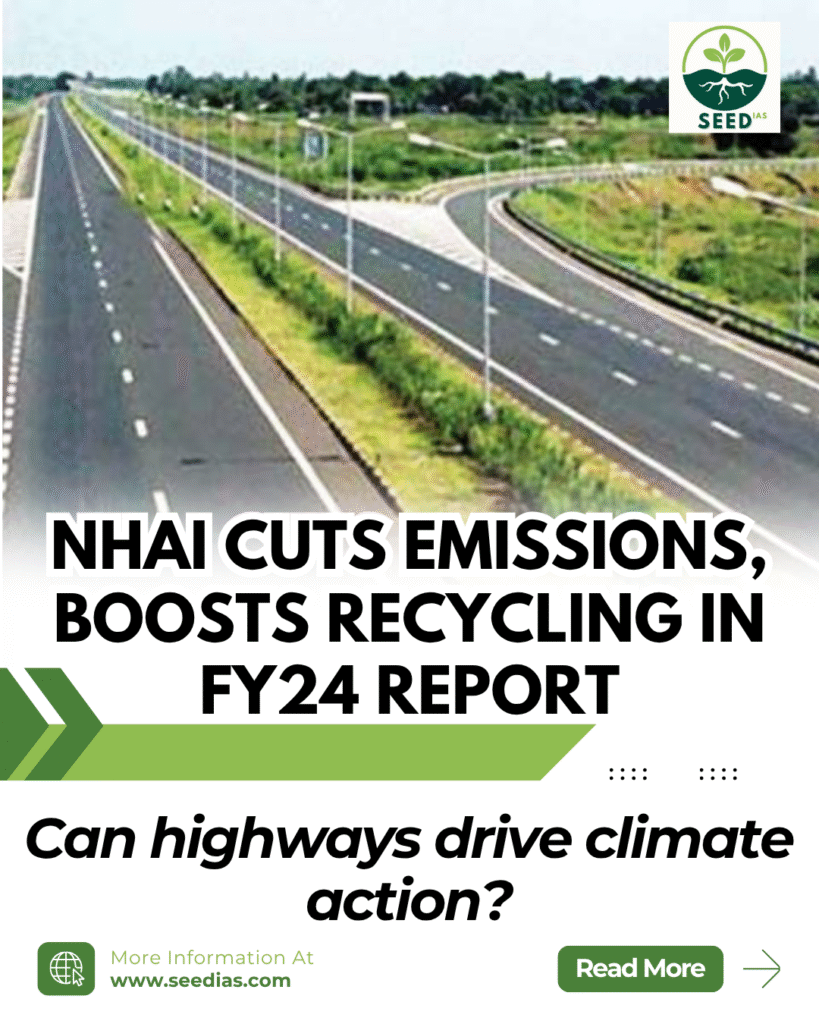Why in NEWS
The National Highways Authority of India (NHAI) released its second Sustainability Report (FY 2023–24), highlighting major strides in environmental performance, aligned with Mission LiFE and circular economy principles, amid rapid infrastructure expansion.
Key Terms and Concepts
| Term | Explanation |
|---|---|
| Mission LiFE | Lifestyle for Environment initiative launched by India to encourage sustainable living |
| Circular Economy | Economic system aimed at eliminating waste and continual use of resources |
| ESG Principles | Environmental, Social, and Governance standards for responsible operations |
| GHG Emission Intensity | Emissions per unit of activity (e.g., MTCO₂e per km of highway construction) |
Major Sustainability Achievements of NHAI (FY 2023–24)
| Area | Achievements |
|---|---|
| Emission Reduction | Despite 20% increase in highway construction, GHG emission intensity dropped from 1.0 to 0.8 MTCO₂e/km |
| Circular Economy | 631 lakh metric tonnes of recycled materials used (e.g., fly ash, plastic waste, reclaimed asphalt) |
| Water Body Creation | 467 water bodies developed under Amrit Sarovar Mission; recovered 2.4 crore m³ of soil, saving ₹16,690 crore |
| Water Efficiency | Achieved 74% reduction in water use intensity in water-stressed areas |
How to Synergise Infrastructure with Sustainability
| Strategy | Description |
|---|---|
| Green Infrastructure | Use nature-based designs like permeable pavements, urban forests, bio-swales |
| EIA and SEA Integration | Apply Environmental and Strategic Environmental Assessments early in planning |
| Use of Sustainable Materials | Employ recycled, low-carbon, and locally sourced materials; promote waste reuse |
| Green Cover Expansion | Implement afforestation, tree belts, and ecological buffers with “Tree First, Road Next” approach |
| Water Conservation | Use stormwater harvesting, greywater systems; rejuvenate lakes and rivers |
| Biodiversity Safeguards | Build eco-bridges, wildlife corridors, and underpasses to prevent habitat fragmentation |
| Low-Carbon Transport | Focus on EV-ready highways, NMT paths, mass transit systems, and freight corridors |
| ESG & Policy Alignment | Align with NAPCC, Mission LiFE, SDGs; promote ESG audits and public sustainability reporting |
About NHAI
| Feature | Details |
|---|---|
| Status | Statutory body under Ministry of Road Transport and Highways |
| Act | Established under NHAI Act, 1988; operational from 1995 |
| Governance | Led by a Chairman with up to five full-time and four part-time members appointed by the Centre |
| Function | Develops, maintains, and manages India’s National Highways network |
In a Nutshell
Memory Code – H.I.G.H.W.A.Y.
Highway growth with lower emissions
Integrated ESG reporting
Green materials reused
Harvested water via Amrit Sarovar
Waste turned into wealth
Afforestation and wildlife safeguards
Yardstick: Emission per km built
Prelims Practice Questions
- Which of the following materials were reported as reused by NHAI under circular economy initiatives in FY 2023–24?
1. Fly ash
2. Plastic waste
3. Reclaimed asphalt
4. Biomass pellets
Select the correct answer:
A. 1, 2 and 3 only
B. 2, 3 and 4 only
C. 1, 3 and 4 only
D. All four - Which of the following best describes Mission LiFE?
A. A policy for promoting tourism in India
B. A public movement for adopting sustainable lifestyles
C. A green energy subsidy scheme
D. A wildlife conservation programme - What is the key difference between EIA and SEA?
A. EIA is conducted for regions, SEA is project-specific
B. EIA and SEA are the same processes
C. SEA is for strategic plans or policies, EIA is for individual projects
D. SEA focuses on social impacts while EIA focuses on environmental ones
Mains Practice Questions
- How can India’s infrastructure growth be harmonised with sustainability? Discuss with reference to the NHAI Sustainability Report. 15 Marks (GS3 – Environment, Infrastructure)
- Critically examine the role of circular economy and ESG principles in transforming India’s construction sector. 15 Marks (GS3 – Environment, Economy)
Prelims Answers and Explanations
| Qn | Answer | Explanation |
|---|---|---|
| 1 | A | Biomass pellets were not mentioned; fly ash, plastic waste, and reclaimed asphalt were used |
| 2 | B | Mission LiFE stands for Lifestyle for Environment, promoting eco-conscious living |
| 3 | C | SEA assesses plans/policies, while EIA evaluates specific development projects |
















